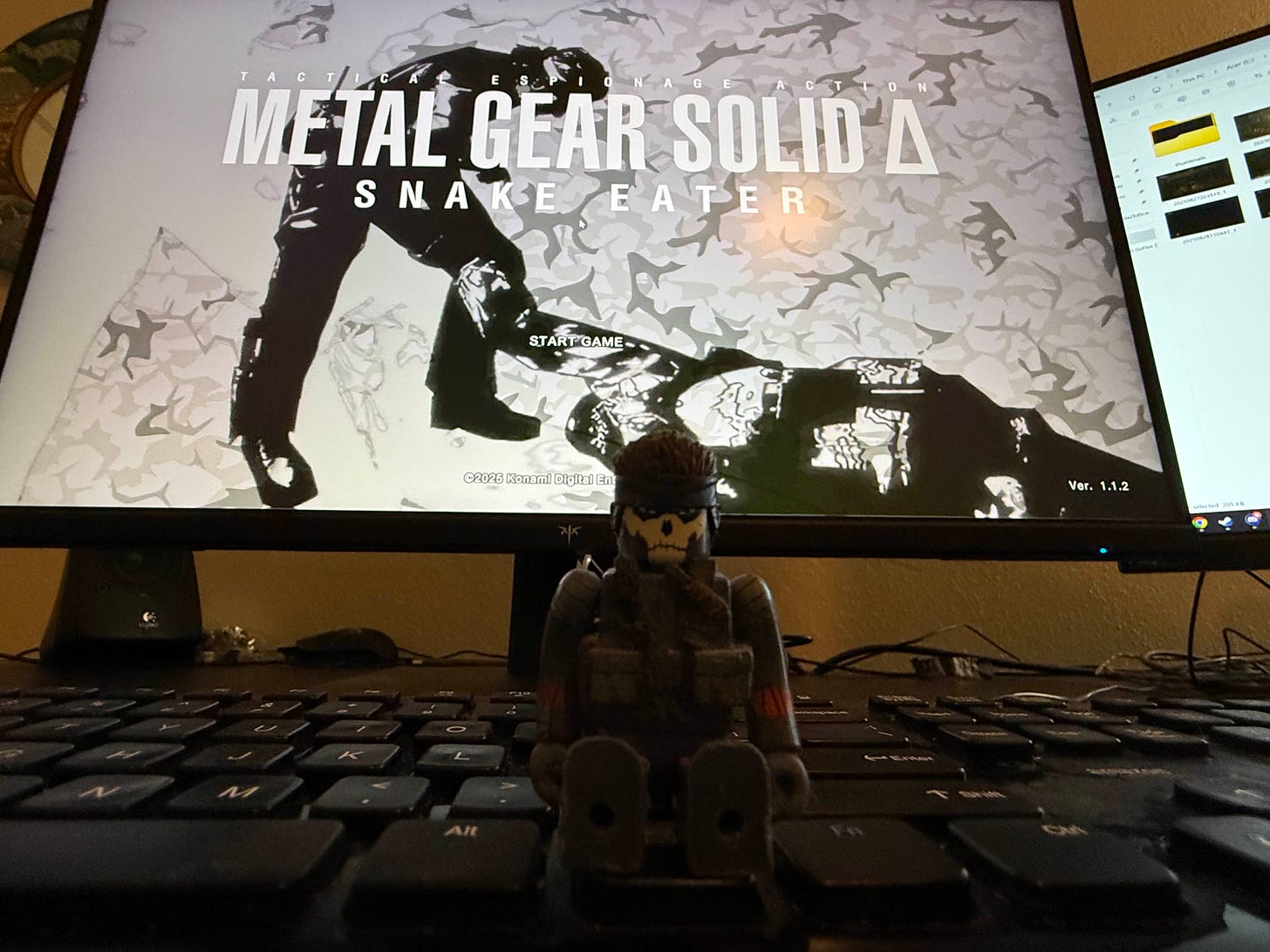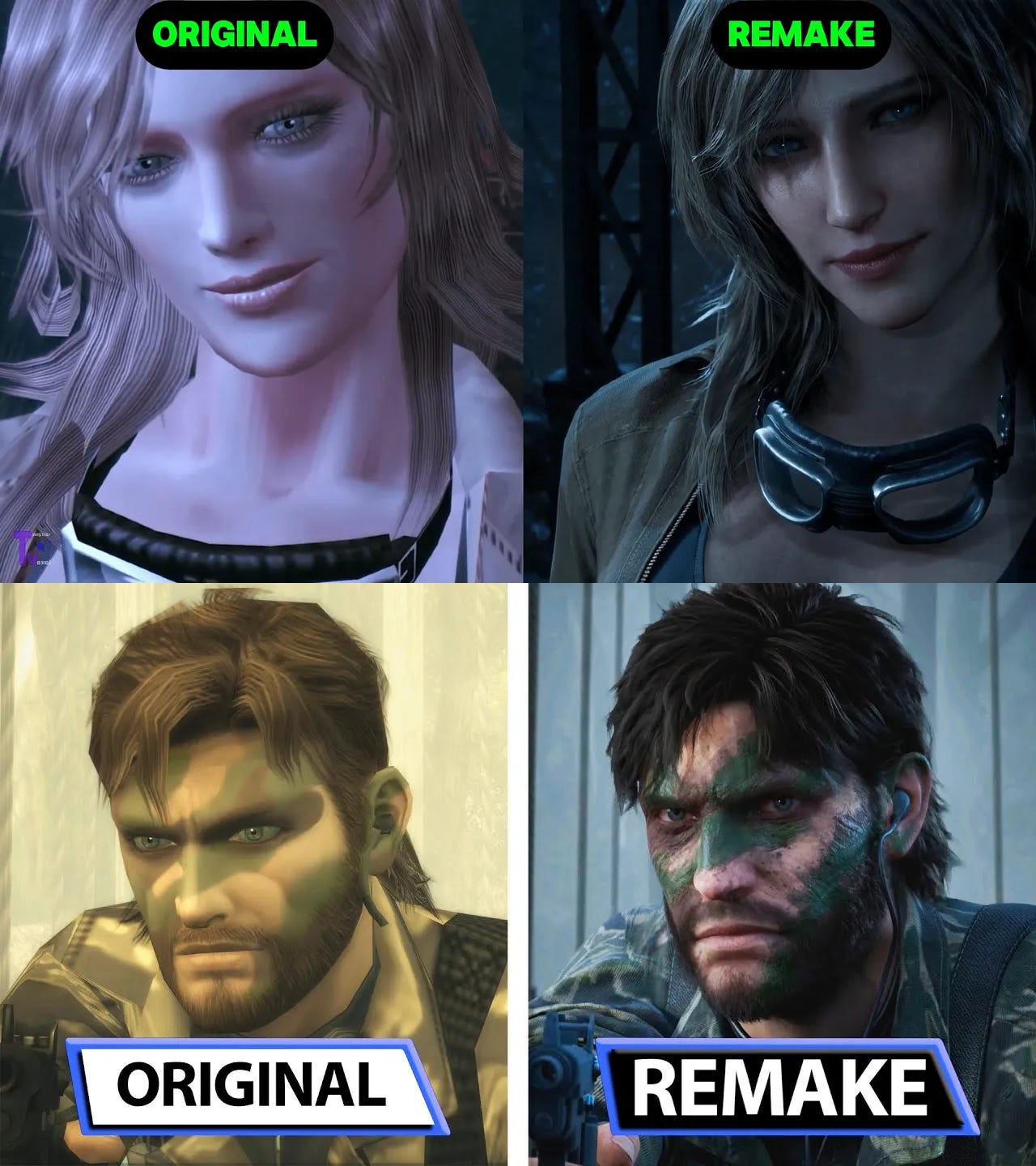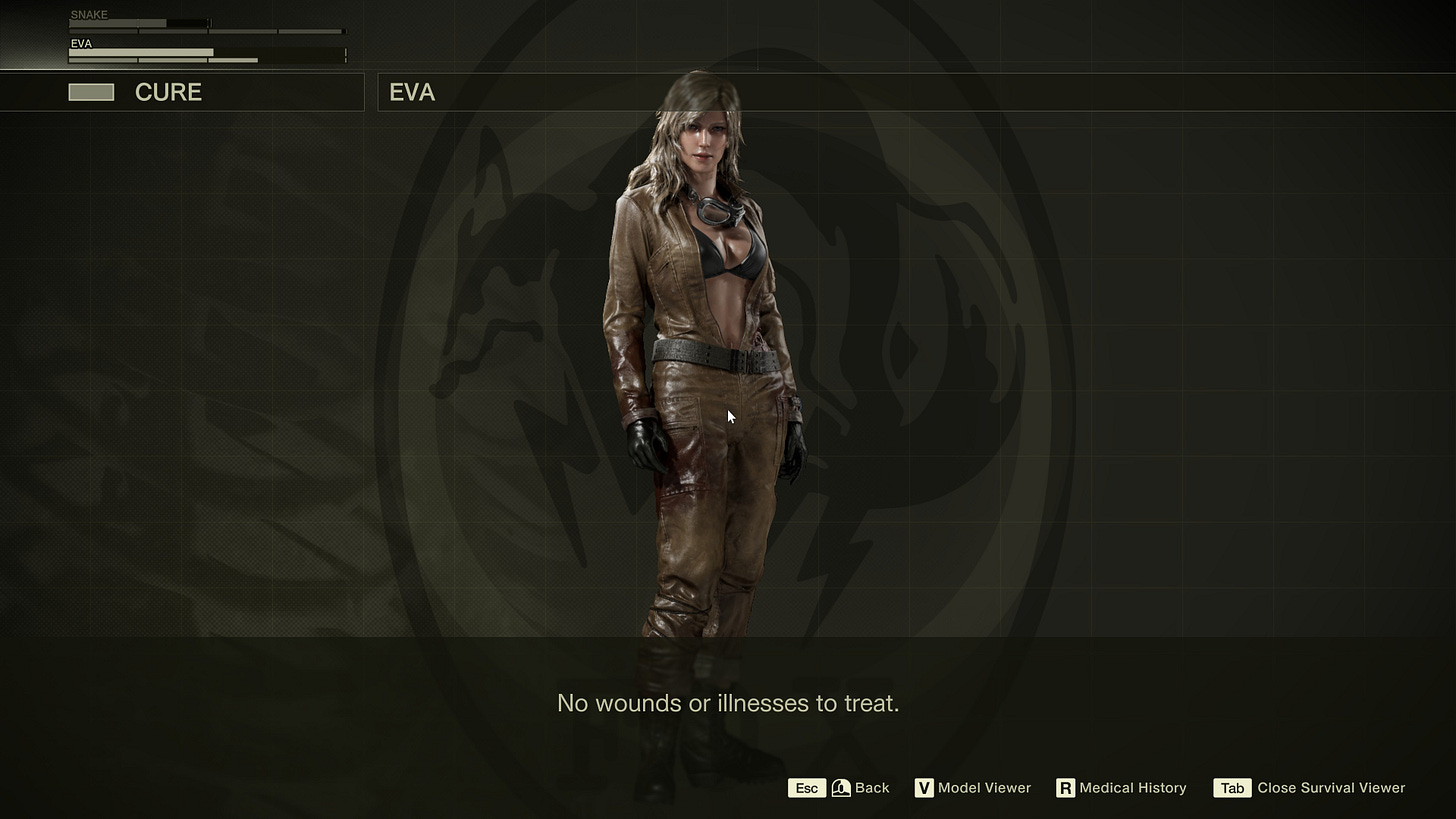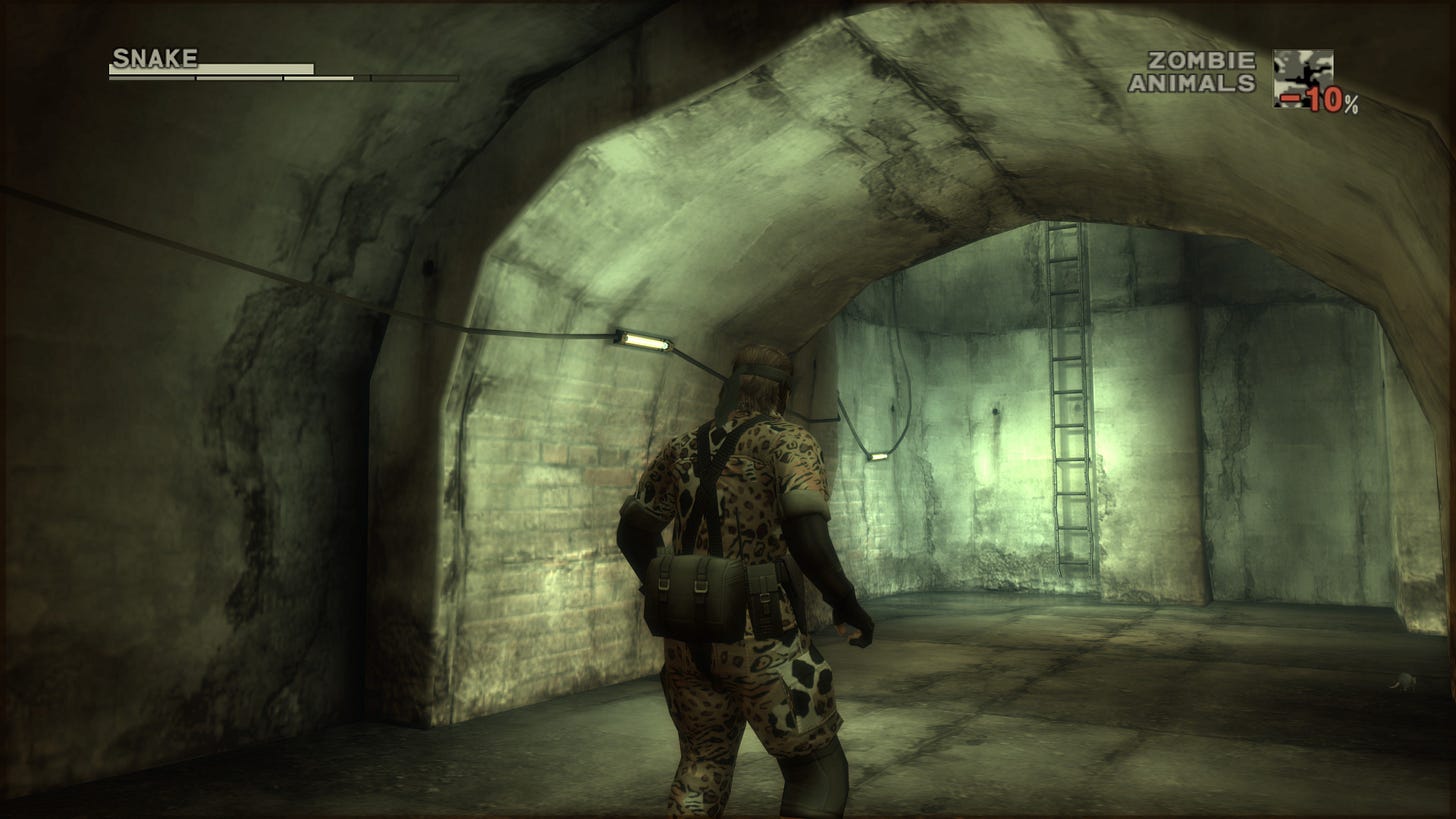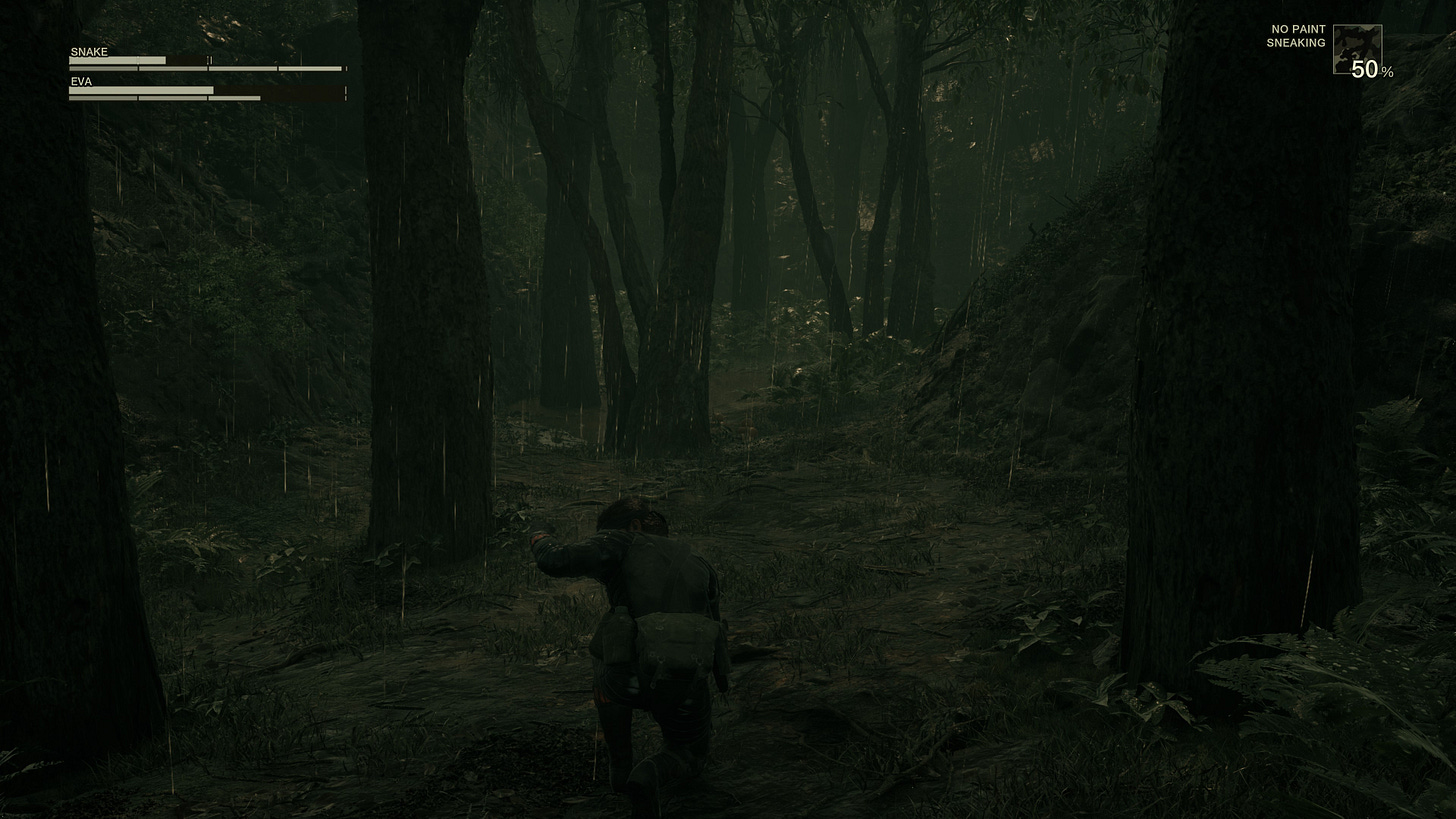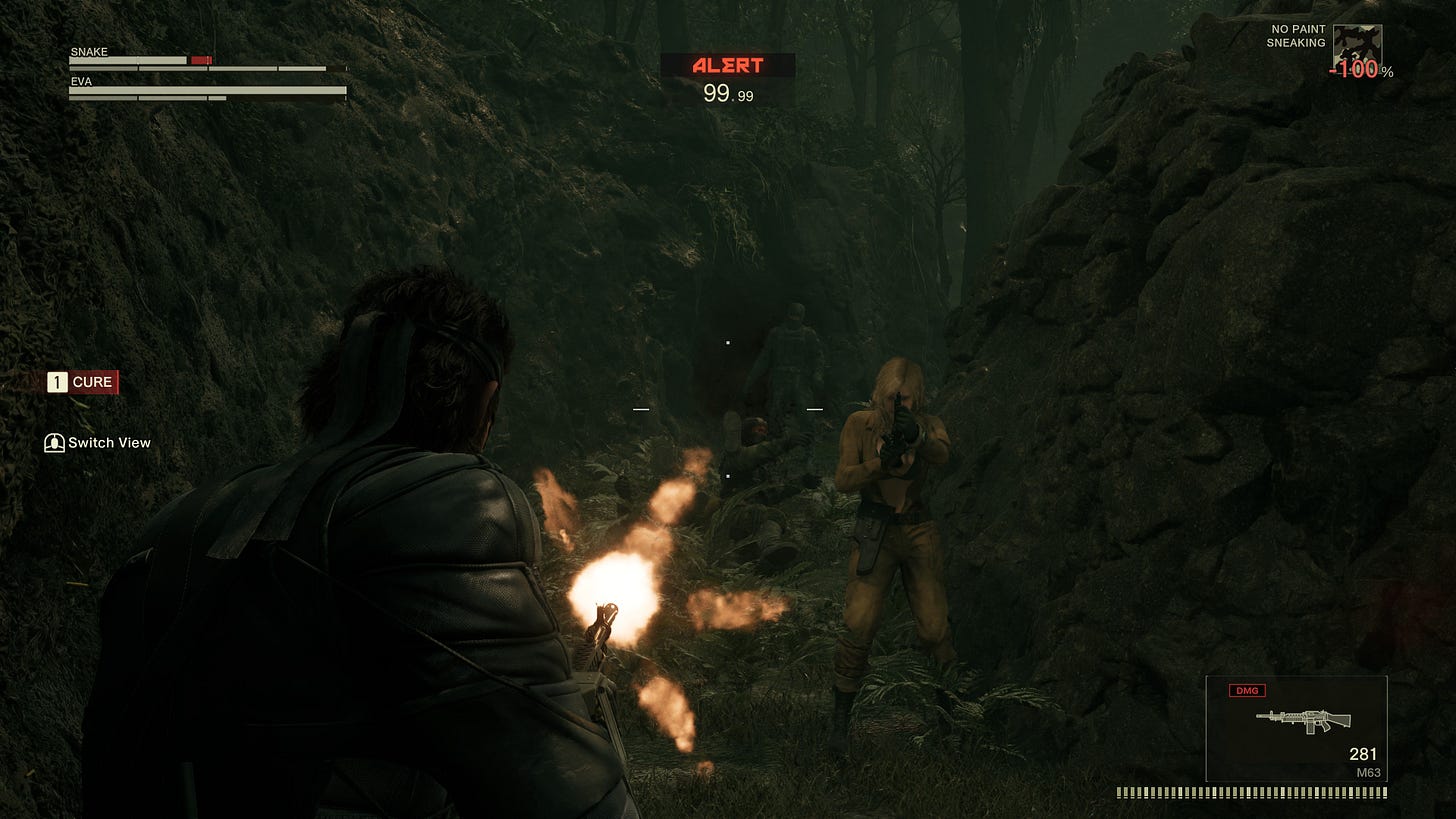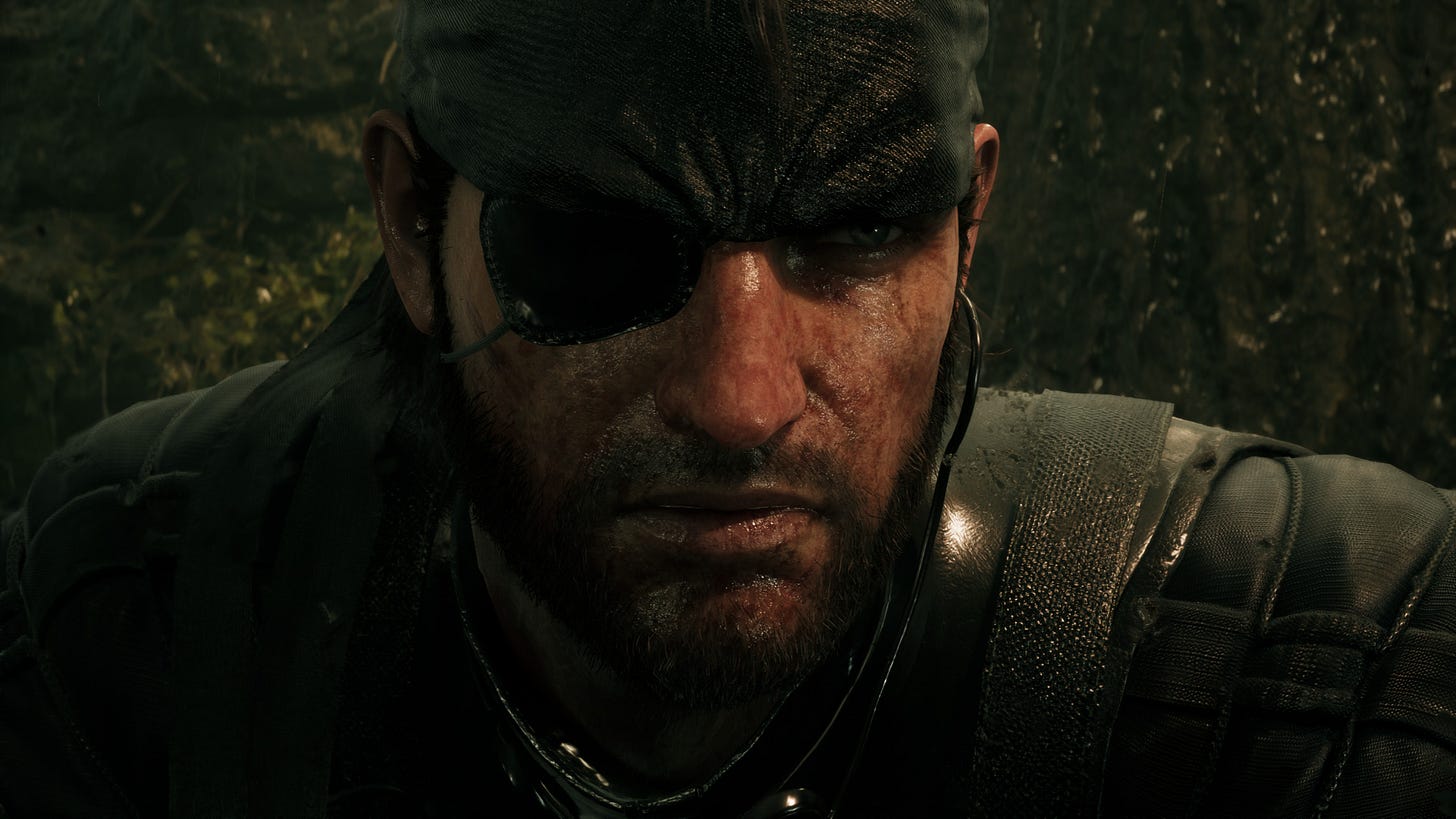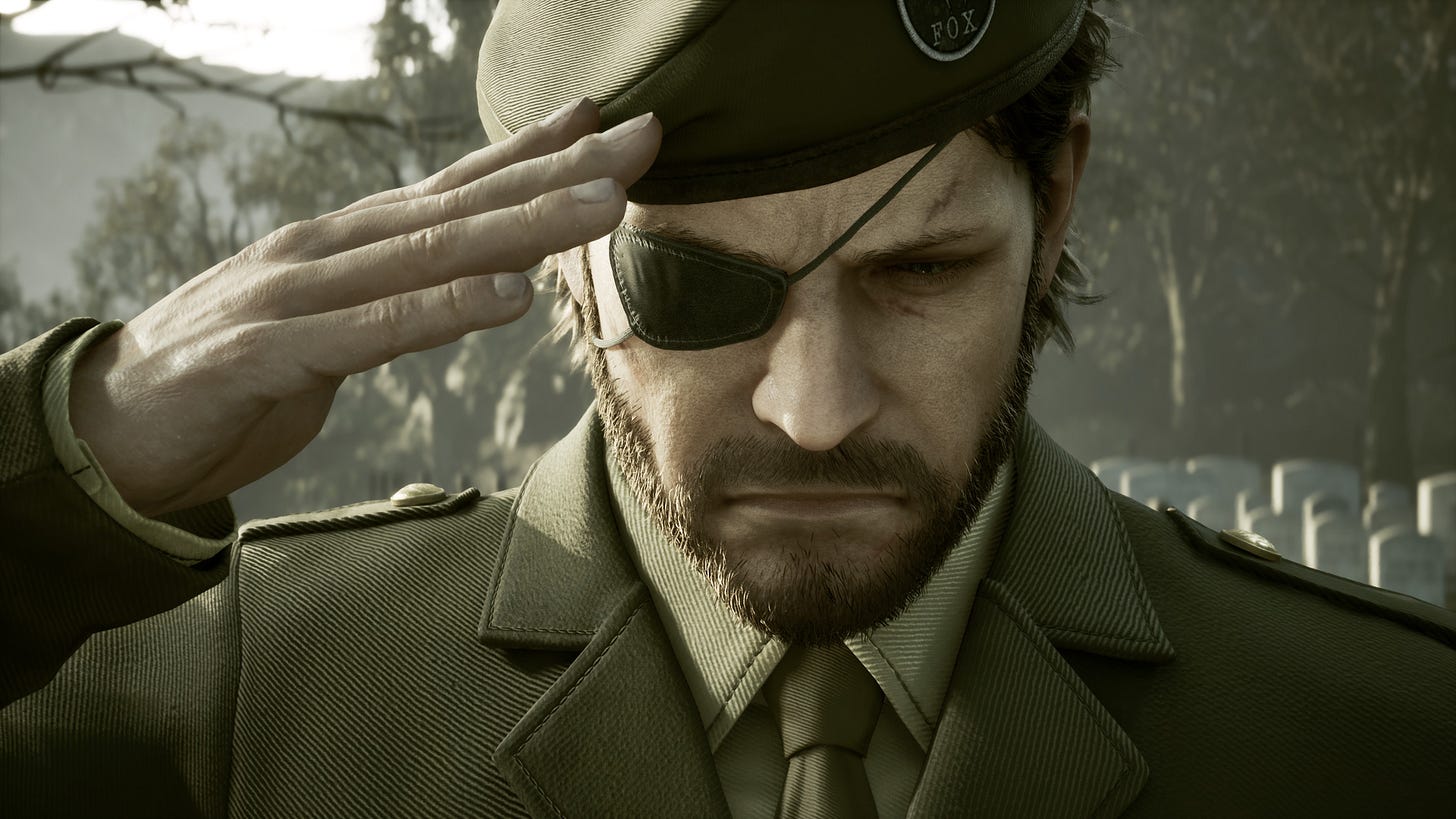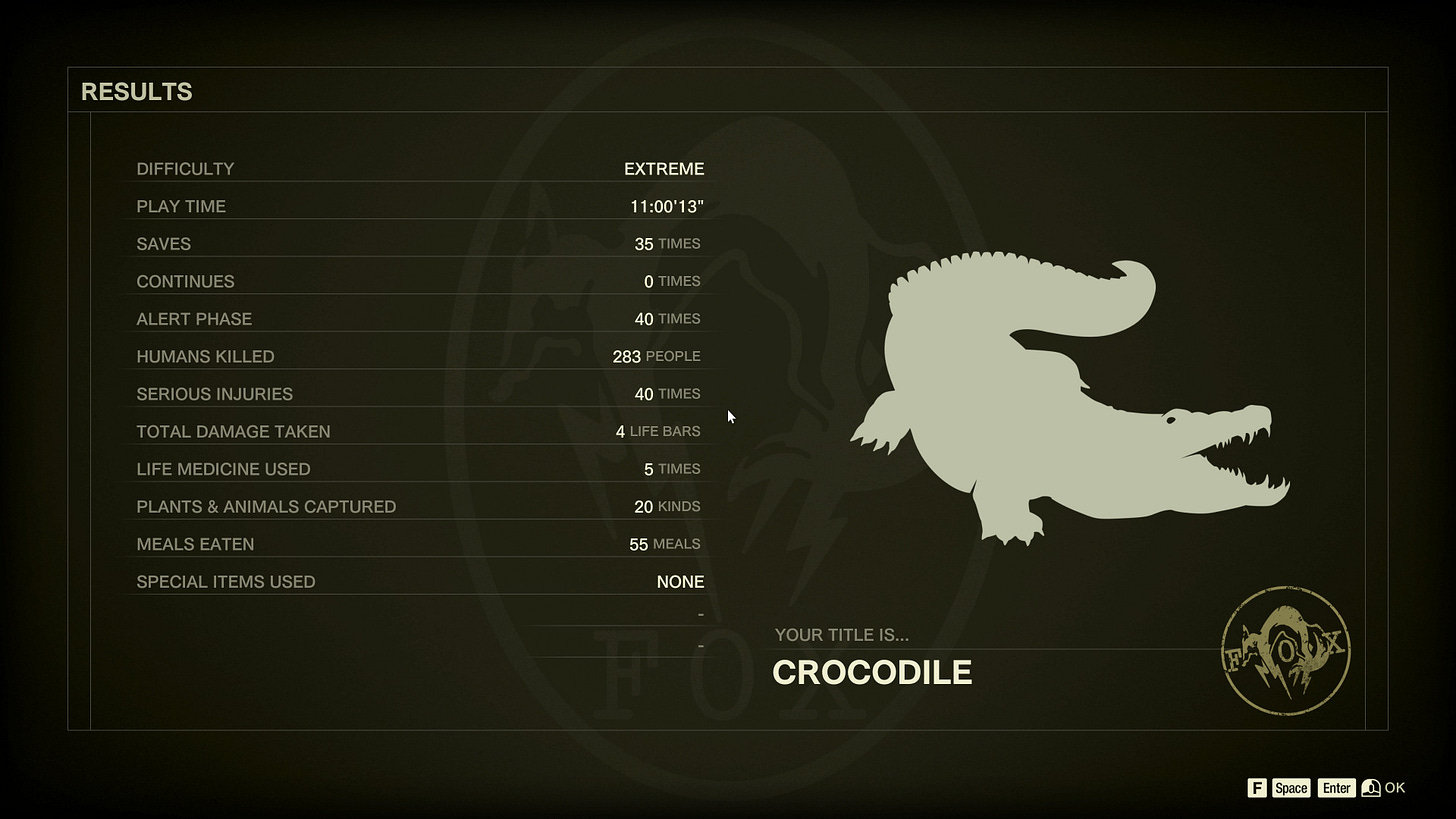When it was announced in 2023 that Metal Gear Solid 3: Snake Eater would be the first of the classic 3D Metal Gear games to receive a remake, I and so many other fans of the series rejoiced. The choice to start with the series’ third entry could be questioned only by outsiders. Snake Eater is Metal Gear Solid’s chronological beginning, but also its indisputable height, where its narrative, level, and gameplay design all cohered into the absolute zenith of the franchise. Metal Gear Solid has primitive graphics; Metal Gear Solid 2 has Raiden; Metal Gear Solid 4 has way too many cutscenes; Metal Gear Solid V has no ending and the worst twist of all time: but 3 has no such fundamental flaw. 3 is the Big Boss.
Snake Eater is the best Metal Gear Solid game, by a lot. With the Subsistence upgrade I am of the opinion that it is as close to perfection as any video game can ever be, given the context of when it was released.
Snake Eater also happens to be my favorite Metal Gear Solid, and the entry that holds the most personal significance in my life. Many long days home sick from school were spent skulking through the swamplands of, uh, Siberia. I remember summer afternoons where I returned to Groznyj Grad, eating pizza with my brothers and playing “Guy Savage.” Sleepover nights with my best friend Timothy were whittled away by shooting Major Rykov in the dick with tranq darts. When the HD Collection came out in 2011, it became my Thanksgiving tradition for a decade thence to replay the game while the smells of roasting turkey and simmering stuffing wafted into the living room.
More hours were spent making my own fun in Snake Eater than any other game growing up, aside from Halo 2. When I returned to it at the end of high school and finally beat it on a non-lethal European Extreme run, I rediscovered the story, and became convinced that Hideo Kojima was a genius of our time—even if V had not been all I hoped for. After making some money for the first time working as an actor, I had to talk myself down from blowing it all on a $200 Naked Snake statuette.
All this navel-gazing is to make the point that Snake Eater is a decidedly played-out game for me. I know each line of dialogue and every inch of every level. Though I hadn’t finished it since 2016, and some details of how to beat specific bosses and where to find certain weapons had left my memory, there was nothing new for me to discover while I entered into Δ’s embrace. As I loaded up the first cutscene and heard David Hayter’s familiar voice, already that familiarity was a little too close, like maybe nine years still hadn’t been long enough.
This is the frame of mind I use as I evaluate Metal Gear Solid Δ: Snake Eater’s merits as a remake.
After the End of World War 2….
Δ is an exactingly precise remake. There is no reimagining here. It is shot-for-shot, made with tremendous love and care for the original, bringing what could be called outdated graphics and controls into the modern generation. Unlike the The Twin Snakes, the GameCube remake of the original Metal Gear Solid, the style of the cutscenes has been maintained, while the visuals have been updated spectacularly.
The character animations are spectacular. The cutscenes seem unaltered, but I know the faces, the ways in which the bodies move, could not possibly have been so detailed in 2004. It’s a cliche, but I mean it when I say Metal Gear Solid Δ looks how I remember Snake Eater looking in my childhood memory. It is a beautiful game.
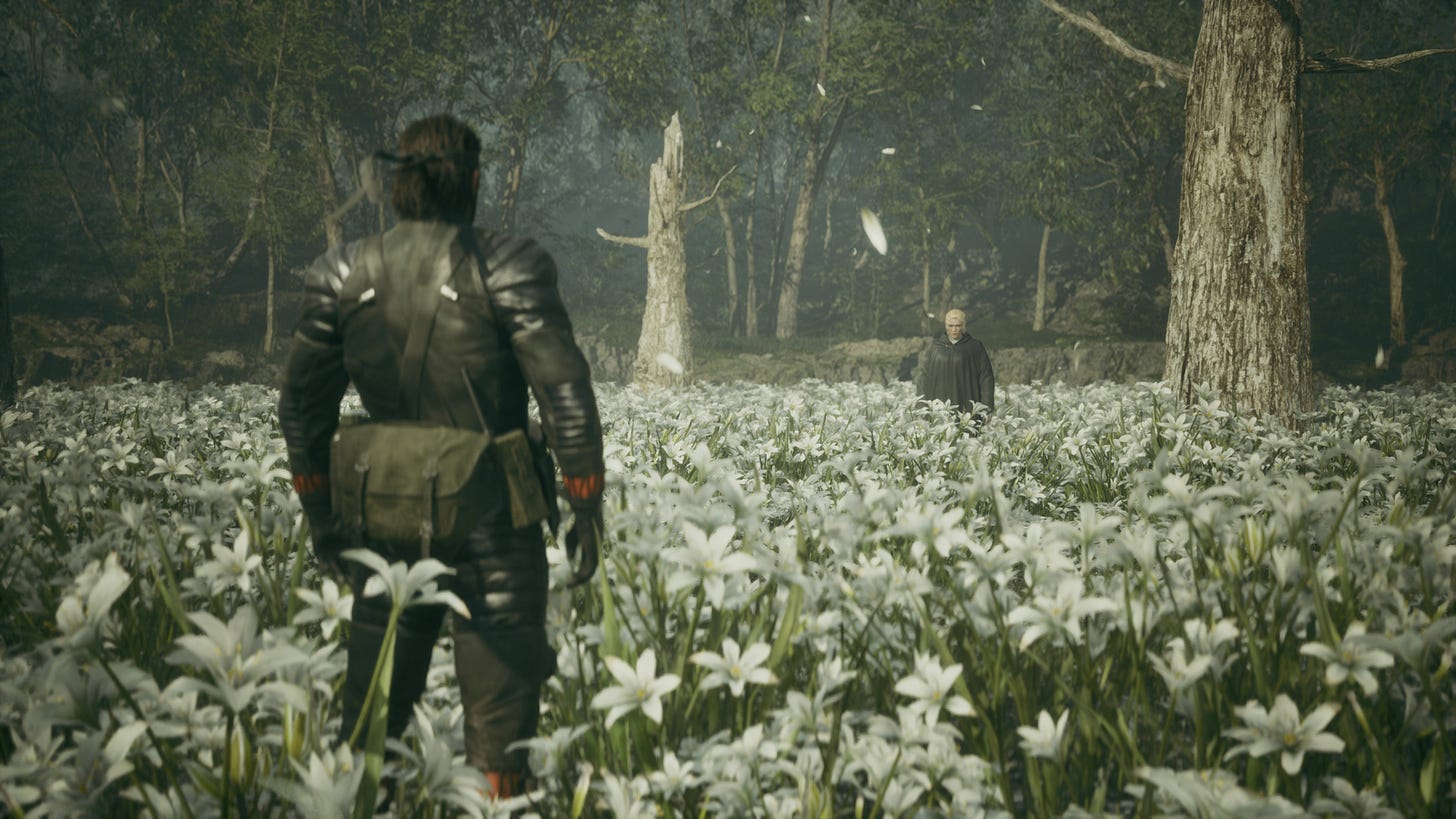
Nevertheless there are some questionable visual departures from the original. Snake, Ocelot, and Eva have all received redesigns. More than “liking” or “disliking” their new faces, they were different enough to be distracting. I never found myself getting used to the changes, which wasn’t the case with The Last of Us: Part I several years ago.
But not The Boss. She must be most amazingly rendered character I have ever seen in a video game. I can’t criticize members of the Cobra Unit, or Volgin, either. Still one must question why the main cast was altered so significantly in a remake that otherwise focuses so strongly on fidelity to the original. Those of us who care about fidelity are surely going to notice changes to character appearance more than anything else, no?
For my part, I wouldn’t have lost sleep over Groznyj Grad getting another tunnel or two. But I am annoyed that Snake doesn’t look like Snake.
But the game is otherwise intact. Every level. Every boss fight. Every physics interaction and enemy behavior and sound effect and exploit you remember from Snake Eater. All have been faithfully recreated in Unreal Engine 5, presumably at great effort, to create what should be the perfect remake. Nothing has been removed for being too problematic. You can still see Eva’s history of receiving breast enhancements in the Survival Viewer. The only significant change to the gameplay is that projectile drop has been added to the Mk. 22, thus nerfing non-lethal runs. Everything else feels the same.
One would think that this is good news, given that I began this review with the claim that Snake Eater is and was a perfect game. If nothing is changed from perfection, nothing can be ruined. Certainly I do not trust Konami, nor even Kojima himself, to improve a masterpiece like Snake Eater without damaging it in the process, like a surgeon with sausages for fingers reaching inside your colon in search of something very small.
I commend the developers for restraining themselves for this reason. I would give a strong recommendation to Δ for fans and newcomers alike were this truly the case. Surely we are left with updated, modernized, beautiful perfection as a result?
Alas there are changes after all. Not to the game’s content, but to its systems, and they are not so benign. They introduce flaws where before none were found.
The World Was Split Into Two
The first decision presented in Δ is whether to play the game in “New” or “Legacy” Style. This will affect everything that follows.
New Style controls turn Δ into a facsimile of MGSV. The camera is limited-FoV and always third-person. CQC is performed with the right trigger, while aiming with the left trigger will turn the right trigger into the fire button. Snake cannot shoot without aiming in this scheme. Rolling has been given a dedicated button. Equipment is controlled with the d-pads. The biggest departure from the original is the introduction of crouch walking, which works just as you might expect. Snake had not discovered this technique in Snake Eater and would be forced to crawl if attempting to move while crouched previously. Now he can simply move while half-prone.
I played the entire game in New Style for the sake of experiencing the remake.
The controls in the classic Metal Gear Solid games were not intuitive. They are of their own era and relied on pressure-sensitive button presses to create precision in aiming and leaning, a technology that is both lost to time and completely unheard of on PC when playing with keyboard and mouse. Taking hostages, swapping between first and third person, and simply shooting could require absolutely bizarre contortions of the hand across the controller. It took dozens of hours to get used to these.
Worse, the first three Metal Gear Solid games relied on extraordinarily awkward fixed-perspective overhead cameras. In a 3D game these had the strange quirk of obscuring what often lay just out of sight, so that you might be spotted by a guard three inches from Snake’s nose, simply because the camera was positioned such that he was invisible.
Snake Eater received a re-release in 2005 called Subsistence that addressed this latter problem. It added a true third person camera that the player could swap to at-will. There was no aiming with this camera, like there would be come MGS4, but it completely changed your relationship with the 3D environment. Using these two cameras in tandem always gave an excellent idea of where guards were and where the player needed to go.
The controls were not so easily updated. But they didn’t need to be. I understand that many new players bounce off of Snake Eater’s control scheme today, and I think a remake did have to modernize it somewhat. But while it took an immense dedication to master, it could be mastered. And once a player had mastered corner-leaning, pressure-sensitive aiming, and hostage-taking, the depth was tremendous.
Here we come to Δ’s biggest problem. Where the title says, “the same controls as the original game,” it telling a truth within a lie. Legacy Style does not control anything like the original release of Snake Eater, but it does use its original camera—not that from Subsistence. Legacy Style lacks the true third person camera and forces the player into top-down perspective. You cannot swap between both at-will like you can in Subsistence.
In New Style, you are locked into over-the-shoulder, MGSV-style gameplay. You cannot swap to the top-down camera, ever. You are allowed to go between New and Legacy Style controls without starting a new campaign, but you have to reload from the latest checkpoint when you do. This apparently changes the Mk. 22’s projectile drop-off, and maybe some other things.
Legacy Style is unplayable. You will never be able to see what you are doing or where you are going. I realize that this is what the original version I played with as a kid was like, but I cannot go back to this: it’s awful. But maybe even worse is that Snake’s movement in Δ is tremendously sluggish and awkward compared to the original release. Combined with the top-down camera, it is simply unbearable. I believe the developers wanted Snake to feel “heavier” than he did in Snake Eater due to the improved quality of the animations, but they made a tremendous mistake. After digging out my old Xbox to play some MGS3HD I can safely say that the difference between the two games’ movement controls is like PS1 to PS2.
MGS3 is snappy and precise. Snake goes exactly where you want him to go. Δ is driving a truck by comparison. Positioning along walls is especially unpleasant. There’s no dynamic cover here like in The Last of Us, a feature that this remake badly needed. Snake feels like he’s been superglued to trees whenever you duck against one for cover; they are now an environmental hazard to be carefully avoided. This is nothing like it used to be.
The hour or so I spent replaying the game on European Extreme in Legacy Style was a horrible experience.
This leaves us with New Style. But I’m unhappy to report that, although Snake Eater never felt designed for a top-down camera, it was most certainly not designed for New Style controls.
Nothing has been changed in Δ. Not level layouts. Not enemy design. Not boss mechanics. But being able to move while aiming and crouch while walking has completely revolutionized the gameplay. These new systems feel as though they have been added in because they are expected, because other games in this series and other stealth action titles have them, but not with consideration of the totality of the game.
Consider crouching. Snake Eater is full of places that are accessible only by crawling: narrow passages, crawlspaces, and areas under bridges within trenches. In MGSV there would be similar areas, and one would access them through a combination of crawling and crouching.
Not in Δ. In Δ, these areas are still crawl-only. Because the level design hasn’t been updated in any respect, there are no crouch-accessible locations. Crouching is never necessary, and it really has no effect at all, except as a tool in one’s sneaking arsenal: it’s the same as walking slowly, for the most part.
But it does change the controls significantly. In the boss fight with Volgin, he has a move where Snake must drop to the ground to avoid being shot. In the original game this is a trivial operation. You press the crouch button or roll, then get back up: moving while holding the stand button will make Snake stand, since you can’t move while crouched. If he’s crawling, he’ll soon be standing.
Except now you can move while crouched. Thus instead of standing in this fight, while trying to avoid Volgin’s attacks, Snake will crouch walk. While he’s crouched, instead of standing, he might crawl again.
This happened to me constantly. In places where I simply wanted to crawl or stand, because those were the stages of movement supported by the level, I was instead crouch-walking—moving slowly, for no reason. This was tremendously frustrating, and there was no way around it, no addressing it, and no easy fix. It is a fundamental flaw with how crouch has been implemented in Δ. You will always have to grapple with this issue when you play this remake from now on.
The ability to crouch is a root-level change to movement. A third state of positionality has been introduced that was never meant to be. The entire game had to be re-engineered to support. It wasn’t. The developers grafted it on, and it shows. This was a huge mistake, and it makes Δ much worse than it should have been.
Meanwhile, equipment selection has been moved to the d-pads, to make way for shooting on the triggers. This change has been made with very little thought. Changing weapons quickly is vital in this game; it’s how you reload (yes, really), and it’s necessary on higher difficulties. You need to be able to do it while moving. The game was designed that way.
You cannot walk and use the d-pad at the same time, if that isn’t obvious.
But there is more. In New Style controls, Snake cannot shoot while aiming. This introduces a legion of bizarre issues. Certain boss fights, like the Fear, are now far harder, because every bullet must be manually aimed. Others, like Ocelot, are of course trivially easy—because the aiming challenge has been almost entirely removed. Stun cigarettes are now useless; in the past Snake could strafe past enemies and puff his cigarettes to knock them out, but they’re terrible when you have to aim, slowly walk up to your victim, and deliberately blow smoke into his mouth from point-blank range.
You can’t fire from the hip anymore, and you can’t run through a map screaming while slaughtering guards. You must go slowly and aim.
Control issues come to a head during the Shagohod sequence. The New Style camera is a disaster during the bike chase. Because you can’t swap between New and Legacy styles on the fly, they’ve opted to use the original game’s camera work—with cinematic shots following the bike—that snaps to third person while you aim. But because there’s no spatial relationship between where Snake aims and where the camera points, it is the most tremendously jarring and disorientating sequence of any game I’ve ever played. A GRU soldier will appear beneath a bridge, right in front of Snake, and you will aim to shoot him—and your camera will snap 200 degrees around to face the opposite direction, showing you a wall, and you will have no idea what you’re looking at.
In Subsistence, you could simply use third person mode in this section, and it would cause no problems. Going back and forth between third-person and cinematic cameras felt natural and did not induce vomit. While in the “Legacy” camera mode, you could aim and shoot while on the bike, without having to go into third person at all. The removal of hipfire autoaim is the primary culprit in introducing such a weird, painful incongruence with the original game.
MGS3 was not designed to be played this way. It wanted you to use your infinite ammo to open up on those soldiers with the M63. You were not meant to painstakingly aim in third person mode, fiddling with a camera facing the wrong direction, battling your own disorientation, while being chased by Volgin.
Just like MGS3 wasn’t designed for crouch walking. Just like MGS3 wasn’t designed for equipment select on the d-pad. These features do not belong to this game.
East and West
If you have never played Snake Eater, you won’t be overbothered by quibbles with the camera, and I doubt you’ll feel so compelled to non-lethal takedown Volgin that problems standing up and down while dodging his attacks on Extreme difficulty cause you much grief. If you are young, if you missed Metal Gear Solid, if you have a high tolerance for the Japanese and like stealth games, pick up Δ. It will be a far more palatable experience for you than grappling with Subsistence’s controls and staring down the PS2-era graphics.
But I am not that person. I can review this game only from the perspective of myself. And I am left with a simple question:
Is this a better version of the game than the one I have been playing since 2011?
Its controls are awkward and take a lot of practice. But beyond this much, I don’t have any issues with Subsistence on my old MGS: HD Collection. It’s an amazing game. It is almost perfect. I don’t even think the graphics look dated; despite their age, what Kojima managed on the PS2 is spectacular. His art style holds up very well. (Although I have to admit, the lip syncing is dogshit in English. Δ fixes that, thankfully.)
Δ is not perfect. Not even almost. It has multiple small but foundational issues that will always mar it. The ability to play it as a third person shooter is neat, but it’s not what the game was meant to be. Without a reimagining, it never will be. So it can never be the best way to play this game. It can only ever be neat. It’s not the actual game. It’s not Subsistence. It’s not a replacement for the original.
The graphics could be. The enhancements are amazing. If it wasn’t for the weirdness of Snake’s face and Eva’s hair, maybe they’d be enough to win me over. But these things are two more marks against Δ, and a longing to simply go back to the old version—to play what I know instead.
What’s frustrating about Δ is that it’s so close. If the Legacy Style controls had the Subsistence camera as an option, or if the New Style controls had a toggleable over-the-top view, I would be able to overlook its other control issues much more easily. But this bizarre flaw spoils it badly for me. Δ needed Legacy controls with Subsistence’s camera to be a replacement for the original. Now that I’ve played some of MGS3HD again for reference, it also needed tighter movement that more closely mirrored the original game.
An Era Called the Cold War
Despite all these criticisms, after beating Δ last night in a state of thorough frustration, and despite having had no desire to return to Snake Eater for almost a decade, the first thing I wanted to do this morning was load it up again and keep playing. It still has the mana that Kojima first imbued into the original’s DNA. It still is Snake Eater. I just wish it had been a little better conceived.
There are, of course, severe technical issues. It runs badly on my PC, and Volgin killed me several times due to inexplicable latency and stuttering. I will be charitable and presume that these things are but temporary ailments, soon to be patched. They usually are.
And there are improvements beyond graphics. Savescumming has been trivialized, as you can see above. The new UI is fantastic. Tons more information on a run is available to the player, and you can now New Game+ onto higher difficulties—something that I always longed for as a kid. The additions of quick-codec calls and an instant outfit changer are inspired and make engaging with those systems far less obnoxious.
But is it enough? Do they make up for the terrible new movement, the regressed cameras, and the shitty controls?
No. With these considerations in mind, Δ cannot be the new go-to for Snake Eater. It just isn’t good enough. It’s pretty. And it’s neat. But that’s all it is. Pick it up if you’ve never played it before, but if you’re like me and on a budget, quite honestly, I’d recommend you stay away, or wait until a deep sale.
It hasn’t been ruined. It’s fine, and it’s worth playing at some point. If patches fix Legacy Style controls it might be well worth $70. As it is now, it adds very little. I’m not happy with it overall.
Metal Gear Solid Δ: Snake Eater, continuing the long tradition of games in this series having ridiculous names, is available now on Xbox, PlayStation, and PC. You can buy it here on Steam.
You may have noticed that I didn’t mention any of the game’s narrative components in this review. The truth is, now that I’m an adult, I hated this game’s story. I feel like I could write a million words tearing out its guts in an autopsy, explaining why Kojima’s writing is a joke, railing against teenage-me for being stupid enough to think a post-credits Ocelot voiceover was profound. But I won’t bother. I don’t really care. You know what you’re getting into with a Metal Gear Solid game. I’d rather pretend I still liked this franchise.



